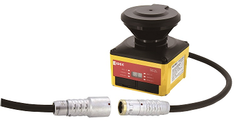
IDEC releases world’s smallest safety laser scanner
IDEC Corporation introduces the SE2L safety laser scanner, the world’s smallest, and the world’s first with master/slave functionality and dual protection zones. A laser scanner is a safety device that uses the reflection of laser beams to detect the presence of objects or people. The scanner is certified for use in safety applications including AGVs, forklifts, robots and other items of moving equipment found in industrial facilities.
Master/slave functionality allows one SE2L scanner to act as master and communicate with up to three other scanners. The safetycontroller only needs to communicate with the master, reducing the required number of input and communication channels on the controller. This can allow lower-cost safety controllers to be used in applications such as providing full 360-degree protection for an AGV, which requires four scanners.
Dual zone protection allows one SE2L scanner to scan two adjacent zones simultaneously and independently, performing the work of two scanners for the cost of one. A common application is providing dual light curtain protection for two robots mounted side by side. In many applications, dual zone protection cuts costs in half.
The scanner provides a standard 270-degree arc of protection at a distance up to 20 meters, and this protection area can be configured into any pattern using either free programming software provided with the scanner, or with the scanner’s teach mode. The software provides drop-and-drag functionality to configure the protection area into any pattern within its 270-degree arc of protection. The teach mode scans obstructions in its standard 270-degree arc of protection to produce a pattern. Up to 32 patterns can be stored in the scanner, and different patterns can be selected and applied on the fly by sending commands to the scannerthrough the Ethernet port, or by configuring the encoder input to react to changes in speed.
A common application for multiple patterns is with an AGV or forklift. A large pattern is used when the equipment is moving at top speed, with smaller patterns used as the equipment slows down. This allows plants to keep safe working distances and reaction times, while still maintaining operating efficiencies.
Up to three different zones of protection can be programmed into each pattern. The Protection Zone is closest to the scanner and extends up to 5m. Warning Zone 1 is next and Warning Zone 2 is farthest from the scanner, with each extending up to 20m from the scanner. Each zone’s shape within the pattern can be configured in the software, and each zone activates a different signal output from the scanner.
The scanner communicates intrusion alerts to a safety controller via four PNP OSSD safety outputs and two PNP non-safetyoutputs. The OSSD outputs have a self-diagnostics function that tests the signal periodically to detect malfunction. The safetyoutputs are commonly used to indicate detection closest to the scanner in the Protection Zone and Warning Zone 1, while the non-safety outputs are commonly used to indicate detection in Warning Zone 2. Two other outputs can be used to request muting. The scanner can also communicate with a safety or other controller via its Ethernet 100BaseTX waterproof connection port.
The scanner is configured using IDEC’s SLS Project Designer Software, which can be downloaded for free. Once the configuration is complete, it can be downloaded to the scanner through its Ethernet port, Micro USB port or Micro SD Card slot.
A 7-segment display on the scanner indicates operational status. This information can also be displayed on a PC connected to the scanner via its Ethernet port to monitor errors, and the information can be data logged to facilitate troubleshooting.
The scanner is certified for use in Safety Category 3, Performance Level d (PLd), Safety Integrity Level 2 (SIL2) applications. It is housed in an IP65 enclosure. In addition to performing its certified safety functions, the scanner can also be used to make highly accurate distance measurements, communicating this information through its Ethernet port to a controller or a PC. It can also be used to measure speed through its incremental encoder input which measures pulses. This function can be used to switch patterns as the speed of a moving item of equipment changes.
Laser beam detection characteristics are 30ms/rotation with one laser beam per 0.125º. There are 2,000 laser beams per rotation through the 270º arc, with an 11mm gap between laser beams at 5m. The minimum detectable size at 30mm at 1.8m, 50mm at 3m, and 70 mm at 5m. The scanner includes both muting and EDM functionality to ensure maximum flexibility and safety.









